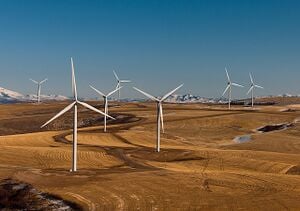
Networks and sustainability initiatives[edit | edit source]
- Community Rising, Social Enterprise based in Ketchum
Climate action[edit | edit source]
Climate change in Idaho[edit | edit source]
In the big picture of greenhouse gas emissions, Idaho emits the least carbon dioxide per person of the United States, less than 23,000 pounds a year. Idaho forbids coal-power plants. It relies mostly on nonpolluting hydroelectric power from its rivers. W
Environment quality[edit | edit source]
The environment of Idaho is rich in ecological diversity. Major forest ecosystems include grand fir-Douglas fir forest, cedar-hemlock-pine forest, Douglas fir forest, western ponderosa pine forest, and western spruce-fir forest. While the northern part of the state is dominated by forests, most of the southern part of the state is covered by sagebrush steppe, interspersed with islands of desert and saltbush-greasewood shrublands.
Many areas in the state are nearly pristine and include some of the largest areas in the United States without paved roads.
Significant fish resources include salmon and steelhead.
Idaho Department of Environmental Quality
Open spaces[edit | edit source]
Yellowstone National Park is the most famous of the region's protected areas. Its intact grizzly bear habitat, rangelands for buffalo, elk, and moose, and spectacular hot springs and geysers attract millions of visitors per year. W
Community energy[edit | edit source]
Idaho's energy landscape is favorable to the development of renewable energy systems. The state is rich in renewable energy resources but has limited fossil fuel resources. The Snake River Plain and smaller river basins provide Idaho with some of the nation's best hydroelectric power resources and its geologically active mountain areas have significant geothermal power and wind power potential.
Idaho imports most of the energy it consumes. Imports account for more than 80% of energy consumption, including all of Idaho's natural gas and petroleum supplies and more than half of its electricity. Of the electricity consumed in Idaho in 2005, 48% came from hydroelectricity, 42% was generated by burning coal and 9% was generated by burning natural gas. The remainder came from other renewable sources such as wind. W
Wind power in Idaho[edit | edit source]
Wind power in Idaho could generate more energy than the state uses.
Solar power in Idaho[edit | edit source]
Solar power in Idaho comprised 550 MW in 2019. A 2016 report by the National Renewable Energy Laboratory estimated that rooftops alone have the potential to host 4,700 MW of solar panels, and thus provide 26.4% of all electricity used in Idaho. A large increase in the state's solar generating capacity began starting year 2015 when 461 MW of solar power was contracted to be built in Idaho.
Cycling activism[edit | edit source]
Boise Bicycle Project - Wikipedia: Bike paths in Idaho (category)
Sustainable transport activism[edit | edit source]
Wikipedia: Hiking trails in Idaho (category)
Resources[edit | edit source]
Citizens data initiative[edit | edit source]
Other resources[edit | edit source]
Natural Resources, information from Idaho.gov
About Idaho[edit | edit source]
Idaho ( EYE-də-hoh) is a landlocked state in the Mountain West subregion of the United States. It shares a small portion of the Canada–United States border to the north, with the province of British Columbia. It borders Montana and Wyoming to the east, Nevada and Utah to the south, and Washington and Oregon to the west. The state's capital and largest city is Boise. With an area of 83,570 square miles (216,400 km2), Idaho is the 14th largest state by land area. With a population of approximately 1.8 million, it ranks as the 13th least populous and the 6th least densely populated of the 50 U.S. states.
For thousands of years Idaho has been inhabited by Native American peoples.
